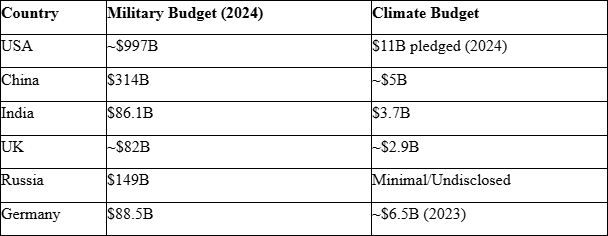Disarmament and Climate Justice
- Tom Vermolen

- Aug 31
- 8 min read
Two Sides of the Same Coin
Akhar Bandyopadhyay

Today, climate activists increasingly face a crucial dilemma: whether to focus exclusively on climate issues as isolated concerns or to also address the broader socio-political injustices intertwined with environmental (and not solely “climate”) degradation. Yet, these struggles are inseparable. The war on nature and the war on people both arise from the same extractivist illogic. Reflecting on insights shared by Satish Kumar during a Schumacher College course I was privileged to attend in July 2025, it becomes clear that this illogic is rooted in a systemic, militarized-industrial mindset. Thus, peace cannot be understood merely as the absence of war; it must instead represent a holistic vision that nurtures the flourishing of all life in deep harmony with nature.
I. Resource Geopolitics: War as Control
War frequently serves as a tool for consolidating control over natural resources that are treated merely as another economic resource. In Ukraine, the conflict’s eastern epicentre is home to coal, gas, iron, rare earth metals, and fertile black soil. Ukraine exports significant quantities of wheat and corn, making it a critical node in global capital’s resource networks.
Israel’s forcible occupation of Palestine usurps control over water and land. In the West Bank, Israel diverts 80–90% of water resources. In Gaza, 96–97% of water is undrinkable, and bombings have produced 22.9–40 million tonnes of toxic rubble. Gaza’s natural gas fields remain inaccessible. As Vandana Shiva terms it, these acts constitute an “environmental apartheid,” linking Palestinian resistance to the broader climate justice movement.
India: “Maoist” Zones or Extraction Corridors?
Many of India’s so-called “Maoist zones” in Chhattisgarh, Jharkhand, Odisha, Telangana, and Andhra Pradesh overlap with forests rich in bauxite, coal, iron ore, and uranium. These regions are supposedly marked by “armed insurgency” and state violence, but are also noted to be sites of intense corporate mining interest.
This raises an urgent question: Are these zones inherently conflict-ridden, or are they deliberately kept unstable to ease extraction?
Where indigenous communities resist displacement, the state often invokes “national security” to justify militarization, leading to surveillance and repression. What unfolds is an ecological counterinsurgency, where mining proceeds while land rights are rolled back.
A few stark examples are given as follows:
Dantewada and Bastar (Chhattisgarh): Rich in minerals and central to Operation Green Hunt; companies like Essar and Tata hold mining interests. Villagers resisting displacement face violent crackdowns.
Kalinganagar (Odisha): With chromite and iron ore; 13 indigenous people were killed in 2006 while protesting a Tata Steel plant. The so-called “Maoist” presence surged after state violence.
Niyamgiri Hills (Odisha): The Dongria Kondh movement resisted Vedanta’s bauxite plans, defending the sacred earth spirit. The state hinted at “Maoist” links, perhaps to delegitimize their resistance.
Singhbhum (Jharkhand): Rich in uranium and copper, and often flagged as a “Maoist” zone. State crackdowns often coincide with corporate encroachment. At Jadugoda, decades of uranium mining by Uranium Corporation of India Limited (UCIL) have left indigenous families with birth defects, cancers, poisoned the soil and water, yet those villagers or several activist groups who demand accountability are branded as insurgents.
In each region, are we witnessing an armed insurgency—or a strategy to displace people by framing resistance as extremism, while corporate interests proceed unchecked?
A parallel emerges in the Char Dham Highway Project in Uttarakhand, now 75% complete (as of 2024). Pitched as enhancing pilgrimage and border connectivity, this 900-km corridor evidently facilitates troop movement near China. The project is presently triggering massive ecological fallout: deforestation of over 40,000+ trees has increased landslides and floods, including one ongoing in Uttarkashi. Like in the “Maoist zones,” this project reveals how militarization and corporate agendas displace communities and irreversibly damage ecosystems, veiled under the brainwashing language of “development.”
II. War as a Driver of Emissions
Contemporary warfare contributes massively to climate warming episodes. The Ukraine war alone has released over 230 MtCO₂e, matching the emissions of Austria, Hungary, the Czech Republic, and Slovakia combined. In Palestine, 1.9 MtCO₂e has been emitted, with rebuilding projected to add 30–31 MtCO₂e, which is more than the annual emissions of roughly 135 nations.
Military activity drives environmental destruction in multiple ways: through the use of explosives and industrial fires that release harmful pollutants; the collapse of infrastructure that disperses toxic materials into ecosystems; prolonged exposure to hazardous chemicals from ammunitions and military operations; and the resurgence of fossil fuel power plants in Europe, triggered by energy disruptions from conflict, which undermines critical climate commitments.
III. Budgets of Destruction vs. Budgets of Preservation
A glance at global budgets reveals a disturbing imbalance:


Global Military Spending (2024): ~$2.7 trillion (approx.)
Global Climate Finance (2021): ~$850 billion (approx.), far below the IPCC’s $4.3 trillion/year target to achieve the 1.5°C goal.
This exposes a self-defeating, debt-oriented, consumerist “civilization” prioritizing destruction over regeneration.
IV. The Carbon “Boot”-print of Militaries
Militaries are exempt from even the Paris Agreement’s emission reporting requirements. This shields their massive carbon footprint from scrutiny.
The US Department of Defence is the world’s largest fossil fuel consumer; if ranked as a country, its emissions exceed 140 others.
Military operations, weapons production, and infrastructure (steel, cement, jet fuel) generate untracked Scope 3 emissions.
Militarism is the most deregulated emitter on Earth. Climate justice must abolish this military exception.
V. The Military–Industrial–Fossil Fuel Complex: The Techno-War Economy
Weapons manufacturers like Lockheed Martin and Raytheon profit from both war and fossil fuel security operations. Oil companies, in turn, demand military protection for pipelines and rigs, especially in the so-called “Global South” or majority-world.
This forms a vicious loop: military protection fuels fossil extraction, and fossil extraction funds militarism.
Stock markets reward this: during the Ukraine conflict alone, Lockheed Martin shares rose 18%, Northrop Grumman 22%, and RTX 8%—profits made from human suffering and environmental destruction.
Petro-capitalism is now evolving into green(-washed) extractivism. In the name of energy transition, states are scrambling for lithium, cobalt, and rare earth metals, often dispossessing indigenous communities.
India’s Critical Minerals Mission, led by Indian Institute of Technologies (IITs) and private consortia, accelerates this trend, extracting from ecologically sensitive indigenous zones, bypassing collective consent. This is climate colonialism under a new banner.
Without the notion of holistic care, the green transition risks becoming a new frontier of ecological violence.
VI. Climate-Induced Conflict and the Risk of Eco-Fascism
Militarism is not only causing climate breakdown, it’s also being framed as a solution:
Climate-induced displacement (1.2 billion by 2050: guesstimate!) is leading to militarized borders in the US, EU, and Australia.
Discourses of “climate security” and “eco-nationalism” are gaining traction, promoting xenophobic geo-political border control in the otherwise borderless planet.
Far-right ideologies are turning to eco-fascism, arguing for the preservation of homelands against “climate migrants”.
Climate collapse is not just ecological, it’s deeply political. Militarized responses to ecological crises risk accelerating totalitarian tendencies.
VII. Bottom-Up Peacebuilding as Climate Solution
Indigenous frameworks offer systemic alternatives. They reject both extractivism and militarism, emphasizing non-violent relationality, reciprocity, and repair.
Examples that inspire contemporary resistance include:
Dongria Kondh resistance
Zapatismo in Chiapas
Buen Vivir frameworks in Latin America
La Via Campesina
MAPA and Climate Justice Alliance etc.
These movements prioritize being-in-community and ecological conviviality. On the other hand, military emissions remain unaddressed in elite “climate conferences”, and climate finance is either delayed or commodified. Impactful solutions lie not in elite negotiation rooms, but in frontline grassroots struggles and lived resistance. Climate justice must be anti-colonial, anti-patriarchal, and anti-militarist. Carbon alone is not the enemy: structural violence is.
VIII. Conclusion: Abolitionist Futures
Borrowing from prison and police abolition movements, we must envision military abolition as a path to ecological repair.
This involves:
Redirecting military budgets to adaptation, agroecology, disaster relief, and ecological restoration
Repurposing military tech for life-affirming constructive work, e.g., drones for rewilding, logistics for climate aid
Enabling soldiers to become landscapers, disaster response coordinators or permaculture practitioners.
This isn’t utopia, it’s planetary necessity.
The tanks that raze cities arise from the same logic that levels forests. Fighter jets soaring over Gaza and Kyiv consume the very fossil fuels that melt glaciers and poison the air. The systemic framework that exploits animals in factory farms and enforces monocultural violence on fields is the same that engineers endless cycles of debt in the “Global South” by manufacturing conflicts as part of the WB-IMF-WTO’s pre-debt-ory (sic) agenda. Banks grease this machinery by laundering money from arms deals, resource plunder, and illicit trades, disguising blood-soaked capital as legitimate flows of investment. War thereby becomes the fast-food recipe of the military-industrial complex, perpetuating itself relentlessly despite its inherently suicidal mission.
Total (general and complete) disarmament is not a distraction, it is climate and environmental justice.
We must organize for a world where the only arms we raise are in compassionate solidarity, not war. Let’s disarm the planet! Shut down arms factories — now!
Postscript: Africa Is Calling
Across Africa, climate activists are uniting to demand:
Military spending cuts,
Redirected funds for climate justice,
Demilitarized climate summits.
Their message is clear: there can be no climate justice without peace. The time to listen—and act—is now.
Sign the petition: Peace, Climate, Justice – Africa Is Calling
References
Satish Kumar and Schumacher College
Kumar, S. (2013). Soil, Soul, Society: A New Trinity for Our Time. Leaping Hare Press.
Author’s reflections from Schumacher College Foundation Course, July 2025.
Ukraine’s Natural Resources & Conflict
U.S. Geological Survey. (2020). Mineral Commodity Summaries 2020.
FAO. (2022). Ukraine: Soil and Agriculture Overview.
World Bank Reports on Black Soil and Agricultural Exports.
Israel-Palestine Resource Control and Environmental Impacts
UNEP. (2024). Environmental Impact of the Conflict in Gaza.
WHO. (2023). Water and Sanitation Standards.
Amnesty International. (2023). Israel’s Occupation: Water Access in the West Bank and Gaza.
Al-Haq & Forensic Architecture. (2024). Ecocide in Gaza: Environmental Destruction and Conflict.
India’s “Maoist Zones” and Resource Extraction
Padel, F., & Das, S. (2010). Out of This Earth: East India Adivasis and the Aluminium Cartel. Orient BlackSwan.
Human Rights Watch. (2010). What Did We Get for It? Mining and Human Rights in Chhattisgarh.
Survival International. (2013). The Dongria Kondh’s Victory at Niyamgiri.
MoEFCC. (2024). Annual Report 2023–24. Government of India.
Char Dham Highway Project
Ministry of Road Transport and Highways. (2024). Char Dham Pariyojana Progress Report.
Down to Earth Magazine. (2024). Char Dham Project: Environmental Costs and Landslides.
War Emissions
Igini, M. (2023). The Carbon Footprint of the War in Ukraine. Earth.Org.
Scientists for Global Responsibility. (2024). Military Emissions in the Ukraine Conflict.
Global Military and Climate Budgets
SIPRI. (2024). World Military Expenditure 2024.
IISS. (2024). The Military Balance 2024.
OECD. (2023). Climate Finance Provided and Mobilised by Developed Countries.
IPCC. (2022). Sixth Assessment Report: Mitigation of Climate Change.
Sauer, Pjotr. “‘We’re the canary in the coalmine’: When will Russia take action on the Climate?” The Guardian, 18 July 2025.
Once in a Blue Moon Academia. “Fortifying India: Reading Between the Lines of the 2025 Defence Budget.” 12 August 2025.
Once in a Blue Moon Academia. “Shut Down Arms Factories to Stop Wars: Dismantling the Global War Profiteering Machine.” 23 August 2025.
Military Emissions and Carbon Footprint
Crawford, N. C. (2019). Pentagon Fuel Use, Climate Change, and the Costs of War. Watson Institute, Brown University.
Belcher, O., et al. (2020). Hidden Carbon Costs of the Everywhere War. Transactions of the Institute of British Geographers, 45(1), 65–80.
Climate-Induced Conflict and Eco-Fascism
IOM. (2021). World Migration Report: Climate Displacement Projections.
Selby, J., & Hoffmann, C. (2022). Rethinking Climate Security: Beyond the Conflict Frame. Climate Policy Journal.
Indigenous and Grassroots Climate Justice Movements
La Via Campesina. (2023). Peasant Agroecology for Climate Justice.
Climate Justice Alliance. (2024). Just Transition Framework.
Esteva, G., & Prakash, M. S. (1998). Grassroots Postmodernism: Remaking the Soil of Cultures. Zed Books.









Comments